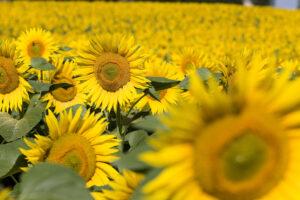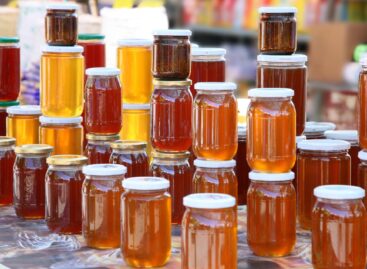Domestic sunflower cultivation is at the forefront of Europe
According to the forecast of Syngenta, the market leader in the field of sunflower seeds, compared to last year’s record 700,000 hectares, the planting area of the plant will decrease slightly this year, but our country is still firmly in the forefront of Europe. The company is continuing its 6-ton program this year, which aims to increase the average yield per hectare.

(Photo: Syngenta)
According to agricultural market forecasts, in terms of Europe, the sown area will decrease in the major sunflower-growing countries, but there is still a lot of uncertainty at the moment. The decrease is caused by low crop prices, slow-moving stocks and declining producer profitability. The protagonists of the sunflower market are Russia and Ukraine, followed on the continent by Romania, Bulgaria, France and Hungary. The Russian-Ukrainian war conflict will definitely affect European agriculture, especially arable crops, considering that Ukrainian exports in the field of grain and oil crops have turned to the European Union, causing difficult competition for the producers of the member countries, according to Syngenta’s analysis. In our country, sunflowers have been growing almost continuously for the past 20 years, and the area has sometimes exceeded 700,000 hectares. In Hungary, too, experts expect a smaller sowing area compared to previous years. According to the forecast, this year’s sowing area is expected to be between 600,000 and 650,000 hectares. Sunflower is mainly used as oil (for food and industry) and as feed from processing, and a smaller part as sunflower seeds for food and bird feed. In addition to domestic use, it is an important export item.
Challenges and opportunities in sunflower cultivation
“Increasingly frequent and unpredictable weather anomalies present great challenges to producers. At the same time, the recent increase in demand for sunflower oil is favorable for the sector. Our national yield average is outstanding among neighboring countries, not least thanks to the knowledge, expertise, experience, openness to innovation and technological discipline of Hungarian producers. Syngenta is the world leader in sunflower breeding, so there is every chance that, together with our producers, we will continue to increase the high national average yield, which is a source of pride,” explained Dr. Dóra Ácsné Szekeres, Syngenta’s sunflower campaign manager. As he explained: the third most important arable crop in our country is the sunflower, which is one of our crops that adapts best to extreme rainfall due to climate change. The return on investment is characterized by a relatively safer, lower production cost per hectare, such as corn. The increasingly unpredictable weather anomalies and hot days affect sunflowers less than corn or canola.
In Hosszúpályi, they harvested 6.4 tons per hectare
Good genetics and hybrid selection are very important. Syngenta’s breeders always strive to breed hybrids that perform best under the conditions of the given country and are resistant to renewable challenges. Thanks to genetic progress and improved cultivation technology, an intensification has taken place in the cultivation of sunflowers, thereby increasing the average yield. The Hungarian yield average is outstanding at the world level: in 2019, for example, the sector achieved a world record with a national average of 3.03 t/ha, and since then it has been possible to approach this level several times. The goal of the 6-ton program of the company, which leads the sunflower seed market with a share of more than 60 percent, is to enable producers to exploit the high yield potential in Syngenta sunflower hybrids as much as possible and, in addition, to make the yield increase profitable. That is why they refine the elements of the cultivation technology together with the producers, developing together. The average yield is greatly influenced by the weather, water supply and soil properties. This is also shown by the fact that in the dry year of 2022, the yield averages achieved in the 6-ton program yield competition were lower. While at that time three achieved an average yield of over 5 t/ha, in the year 2023 with much more favorable weather, 11 could already boast a yield of between 5 and 6 t/ha. And one producer in Hosszúpályi achieved a yield of 6.4 t/ha on an average of 7 hectares with the Sureli hybrid.
Syngenta’s professional program will continue this year as well
“This year will be the third year in which we measure the mineral nitrogen and water-soluble salt content of soils from 0 to 90 cm. In the three markedly different years, we collected a lot of data across the country. These represent an appreciable amount so that we can tell you as precisely as possible what the sunflower needs,” said development engineer Attila Szeleczki. Attila Szeleczki emphasized: the program has already proven that the “6-tonne” performance is not an impossible expectation. Good genetics, the best-performing hybrid among the characteristics of the field are essential. In addition, a good area is also very important, but the weather has a great influence on the crop yield, the effects of which can be reduced at the right time, with properly performed agrotechnology. In addition to these, thanks to the sunflower’s excellent ability to use nutrients, excessive nutrient supply should be avoided, as it not only increases the cost, but can also have a negative effect on the yield and oil content. That’s why it’s worth checking what’s in the soil and replacing only the missing amount, it’s not worth spoiling the sunflower.
Related news
Bird flu reappears in Csongrád-Csanád County
🎧 Hallgasd a cikket: Lejátszás Szünet Folytatás Leállítás Nyelv: Auto…
Read more >Farmers help shelters
🎧 Hallgasd a cikket: Lejátszás Szünet Folytatás Leállítás Nyelv: Auto…
Read more >AM: the Ministry of Agriculture is helping dairy farmers with another tender
🎧 Hallgasd a cikket: Lejátszás Szünet Folytatás Leállítás Nyelv: Auto…
Read more >Related news
KSH: industrial producer prices in November 2025 were on average 2.7 percent lower than a year earlier and 0.3 percent lower than the previous month’s prices
🎧 Hallgasd a cikket: Lejátszás Szünet Folytatás Leállítás Nyelv: Auto…
Read more >Employment at 4.5-year low
🎧 Hallgasd a cikket: Lejátszás Szünet Folytatás Leállítás Nyelv: Auto…
Read more >This is how we eat honey in 2026
🎧 Hallgasd a cikket: Lejátszás Szünet Folytatás Leállítás Nyelv: Auto…
Read more >







